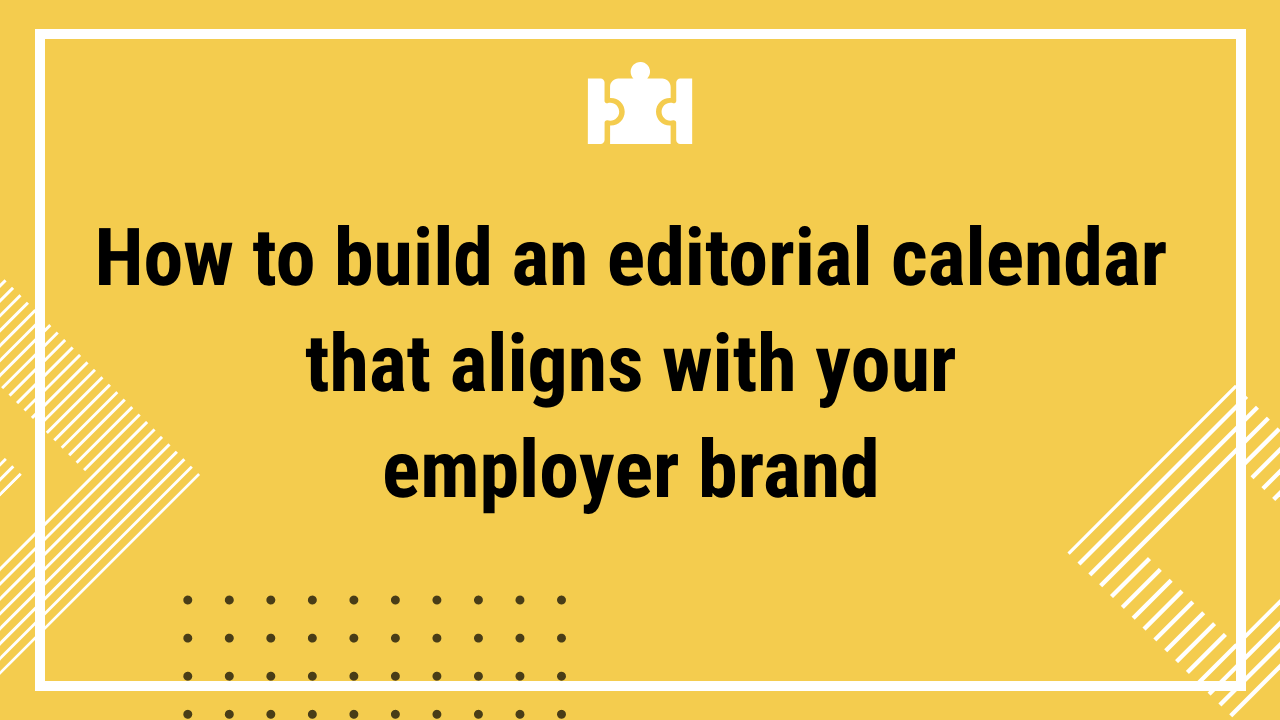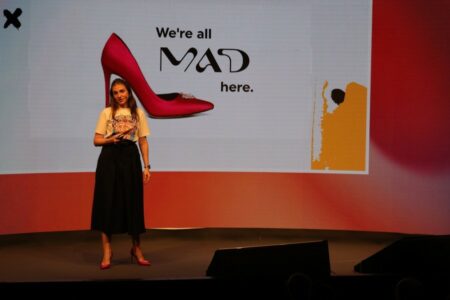A good editorial calendar helps you keep your messages consistent and proactively plan content for your social media channels. By aligning with important events (internal and external), trends, and overall marketing strategy, it turns the act of random posting into a well-organized plan. This approach boosts engagement, creating a unified brand and employer brand image. In simple terms, an editorial calendar helps you stay visible to your target audience.
For any editorial calendar to have value, you should:
Build a content marketing plan that matches your employer brand
Content marketing and employer branding should be bound together by a consistent strategy to shape and communicate the identity of your organization. To get started, make sure to clearly outline what you want to achieve with your employer brand. Are you aiming to attract talent, improve retention, or showcase company culture just to increase awareness?
In simple terms, a content marketing plan should include:
✅ Goals and objectives: Define clear and measurable goals for your content marketing efforts. Whether it’s increasing brand awareness, attracting talent, or driving engagement, having specific objectives will guide your strategy.
✅Target audience: Identify and understand your target audience. Create detailed buyer personas to tailor your content to the needs, preferences, and challenges of your audience segments.
✅Content audit: Evaluate your existing content. Identify high-performing content, content gaps, and areas for improvement. This audit informs your strategy by building on what works and addressing weaknesses.
✅Content types: Determine the types of content you’ll produce. This can include blog posts, videos, infographics, podcasts, webinars, and more. Tailor your content mix to the preferences of your target audience.
✅Content Calendar: Develop a content calendar outlining when and where each piece of content will be published. This ensures a consistent and organized approach to distribution. More details on building an editorial calendar will be provided in the lines below.
✅Keyword Research: Conduct keyword research to optimize your content for search engines. Incorporate relevant keywords naturally into your content to improve discoverability.
✅Distribution channels: Identify the platforms where your audience is most active. Whether it’s social media, your website, email newsletters, or other channels, choose the platforms that align with your goals.
✅Promotion and amplification: Plan how you’ll promote your content. This can include paid promotion, social media sharing, employee-generated content, influencer collaborations, and other amplification strategies.
✅Metrics and analytics: Define key performance indicators (KPIs) to measure the success of your content. Track metrics such as traffic, engagement, conversion rates, and audience growth.
✅Content lifecycle: Plan for the entire lifecycle of your content, from creation to promotion and ongoing updates. Consider how evergreen content and timely pieces fit into your overall strategy.
✅Competitor analysis: Research your competitors’ content strategies. Identify opportunities to differentiate your content and offer unique value to your audience.
By incorporating these elements into your content marketing plan, you’ll create a roadmap for producing relevant, valuable, and engaging content that contributes to your overall business and marketing objectives.
Build an employer brand strategy before creating an editorial calendar
Building an employer brand strategy before creating an editorial calendar provides alignment with your brand identity. Establishing an employer brand strategy ensures a clear understanding of your organization’s identity, values, and culture. This alignment is fundamental to crafting content that authentically represents who you are as an employer.
Furthermore, an employer brand strategy helps identify and define your target audience. Knowing the demographics, preferences, and aspirations of potential candidates allows you to tailor content in a way that resonates with and attracts the right talent.
Putting strategy first is crucial for ensuring content relevance. Understanding your employer brand enables you to create content that aligns with your messaging and values. A strategy guides the selection of themes, topics, and narratives that reinforce your employer brand, making your content more relevant and impactful.
Before developing content, focus on understanding how your employer brand differentiates your organization from competitors. This unique value proposition informs the creation of content that highlights your distinctive features, making you stand out in the job market.
In summary, building an employer brand strategy first provides the essential foundation for creating a purposeful and effective editorial calendar. It ensures that your content is not only aligned with your brand identity but also strategically crafted to meet your organizational objectives.
Employee-generated content: a key element for a value-packed editorial calendar
Employee-generated content is a powerful tool for building a strong employer brand. It brings real stories to life, creating engaging content that reflects your brand. Why is employee-generated content so important and how it can help craft an engaging editorial calendar?
Authenticity amplified
Employee-generated content adds an authentic touch to your editorial calendar, providing real insights into the company culture and employee experiences.
Adobe’s #AdobeLife Campaign is the perfect example of authenticity amplified. The strategy used encourages employees to showcase their workspaces and daily routines, fostering a sense of authenticity. With this campaign, Adobe managed to increase brand transparency, attracting top talent by providing an insider’s view of the company culture.
Diverse perspectives
Employees offer diverse perspectives that can enrich your content strategy. Their unique stories and viewpoints contribute to a more well-rounded and relatable narrative.
HubSpot’s #HumansOfHubspot campaign is a testament to the power of employee-generated content in shaping a vibrant employer brand. Through this initiative, HubSpot employees took center stage, sharing glimpses of their daily work lives and unique experiences within the company. The campaign went beyond showcasing professional achievements, aiming to capture the essence of the company culture.
By spotlighting the people behind the brand, #HumansOfHubspot humanized the company, making it more relatable and appealing to potential employees seeking not just a job but a fulfilling work environment. The campaign effectively utilizes the authenticity of employee stories to strengthen HubSpot’s employer brand and attract individuals aligned with its values and culture.
Showcasing talent
Highlighting the skills and talents of your team through their content not only benefits people, but also showcases the expertise within your organization, enhancing its reputation.
Starbucks’ #tobeapartner campaign is a masterclass in leveraging employee-generated content to foster a strong employer brand. By encouraging Starbucks partners (employees) to share their personal experiences and moments at work, the campaign creates an authentic narrative that resonates with a global audience. From baristas crafting intricate latte art to store managers building connections with their communities, #tobeapartner showcases the diverse and vibrant stories within the Starbucks family.
This user-generated content not only highlights individual accomplishments but also paints a collective picture of a company that values its people. The campaign successfully humanizes the brand, portraying Starbucks not just as a coffee giant but as a community where each partner plays a crucial role in creating the Starbucks experience.
Humanizing the brand
Employee-generated content humanizes your brand. It transforms the organization from a faceless entity into a community of real people, making it more approachable and relatable. Furthermore, authentic employee stories can act as a magnet for top talent.
Coca-Cola’s #LifeatCocaCola campaign brilliantly captured the essence of their workplace culture through employee-generated content. By encouraging employees to share their daily moments, achievements, and behind-the-scenes glimpses, the campaign transformed the company’s global brand into a relatable and dynamic entity. From factory workers to corporate offices, #LifeatCocaCola showcased the diverse roles and experiences that contribute to the magic of Coca-Cola.
The campaign fosters a sense of pride among employees, emphasizing that each person plays a vital role in the company’s success. This employee-generated content not only engages the workforce but also serves as a powerful tool for external audiences, offering an authentic look into the vibrant culture that defines Coca-Cola beyond its iconic beverages.
Consistent content flow
Consistent content flow, powered by the contributions of your people, plays a pivotal role in maintaining a vibrant and engaging editorial calendar. The ongoing participation of your employees ensures a steady stream of diverse content that resonates with authenticity. By incorporating unique perspectives, stories, and insights from your team members, you infuse variety and freshness into your content strategy.
This consistent and diverse flow not only caters to different audience preferences but also prevents monotony, keeping your editorial calendar dynamic and appealing. It’s a proactive approach to content creation, where the collective voice of your employees contributes to a continuous narrative that captures and sustains audience interest over time.
Cultural reinforcement
Cultural reinforcement through employee-generated content is a powerful strategy that goes beyond just showcasing your company culture—it becomes a dynamic tool for celebrating and fortifying the essence of your workplace. By encouraging employees to share their experiences, ideas, and perspectives, you’re not only aligning their content with your organizational values but actively contributing to the reinforcement of the specific cultural traits you aim to cultivate.
How should to structure your editorial calendar
Now that you have your employer brand strategy in place, as well as your people’s willingness to contribute to strengthening your culture, you can start thinking of a structure for your editorial content calendar. Here are some tips on how to get started:
✅Set your objectives: Begin by defining your social media goals. Whether it’s brand awareness, engagement, or conversions, clarity on objectives guides your content strategy.
✅Know your audience: Understand your target audience’s preferences, behaviors, and interests. Tailor your content to resonate with them, fostering stronger connections.
✅Content categories: Create diverse content categories aligned with your employer brand’s voice. Include educational, entertaining, and promotional content to keep your feed engaging.
✅Balance posting frequency: Determine the optimal posting frequency for each platform. Consistency matters, but avoid overwhelming your audience with too many posts.
✅Utilize tools for efficiency: Explore social media management tools that allow you to schedule posts, track analytics, and manage multiple accounts in one place. See more about tools in the paragraph below.
✅Promotions and campaigns: Plan promotions and campaigns strategically. Align them with your marketing calendar and ensure they complement your overall brand narrative.
✅Review and adapt: Regularly assess your editorial calendar’s performance. Analyze metrics, gather feedback, and adapt your strategy based on what resonates best with your audience.
✅Collaborate across teams: Foster collaboration between marketing, sales, and customer service teams. Ensure a cohesive approach to content that aligns with overall business objectives.
✅Stay agile: Be open to adjustments. Social media trends and audience preferences evolve. Stay agile, ready to tweak your editorial calendar to keep your content fresh and effective.
Hubspot has some excellent editorial calendar templates that you can use for free here.
Scheduling tools worth taking into consideration
Scheduling tools have become invaluable assets for businesses, offering a range of benefits that extend beyond mere convenience. These tools empower your organization to streamline content creation and distribution processes, ensuring consistency across platforms. From planning and scheduling posts to analyzing performance metrics, these platforms provide a centralized hub for managing diverse social channels. The top 5 most frequently-used scheduling tools.
Hootsuite
Hootsuite is a comprehensive platform that lets you manage all your social media channels, schedule posts, and analyze performance from one dashboard.
Buffer
Known for its simplicity, Buffer allows you to schedule posts across various platforms and provides analytics to measure your content’s impact.
Later
Ideal for visual content, Later specializes in scheduling and managing Instagram posts. It also supports other major social media platforms.
CoSchedule
More than just a scheduling tool, CoSchedule offers a collaborative calendar for content planning, team coordination, and social media scheduling.
Sprout Social
A robust tool that combines scheduling with social listening and analytics, Sprout Social provides a comprehensive solution for managing your social media presence.
Closing thoughts
There’s no doubt about it: a well-crafted editorial calendar is the linchpin that connects your product brand and employer brand to your target audience. It transcends the chaos of spontaneous posting, transforming it into a well-choreographed dance that maximizes engagement and fosters a cohesive brand image. The foundation of a successful editorial calendar lies in a robust content marketing plan, tied to your employer brand strategy.
Strategy precedes execution. Building an employer brand strategy ensures alignment with your organizational identity, values, and culture. It lays the groundwork for content relevance, guiding the selection of themes and narratives that authentically represent who you are as an employer.
As you embark on structuring your editorial calendar, set clear objectives, know your audience, diversify content categories, balance posting frequency, and leverage efficiency tools. Promotions and campaigns strategically aligned with your marketing calendar add strategic depth to your calendar, creating a cohesive brand narrative. Regular review and adaptation, cross-team collaboration, and staying agile to evolving trends contribute to the ongoing success of your editorial calendar.
As you embark on your journey to build and refine your editorial calendar, remember that each post, each story, and each interaction contributes to the rich tapestry of your employer brand. With strategy as your compass and employee-generated content as your authentic voice, you’re poised not just to engage but to connect with your audience, forging lasting relationships in the digital landscape.





